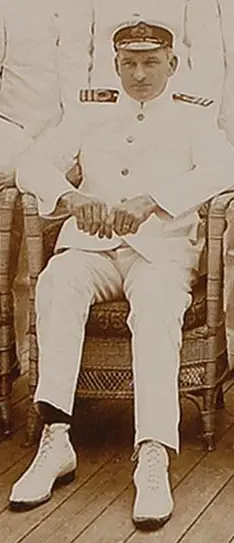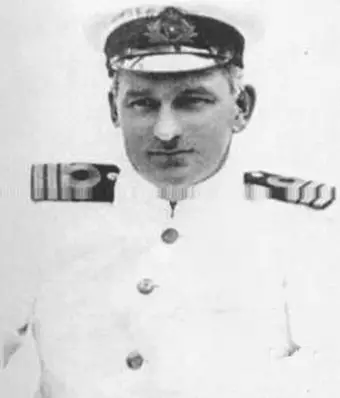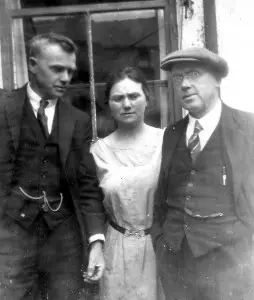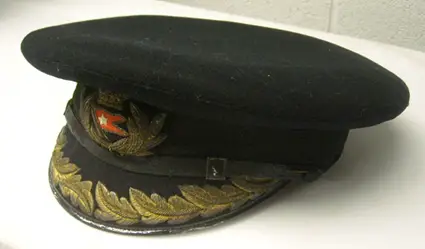Side Menu:
Chief Officer Wilde
Wilde 'Enigma' Myth
Wilde is frequently refered to in various articles and publications as being an 'enigma' as he was seemingly 'inactive' and very little known about his activities during the evacuation and sinking of the Titanic. However there is enough evidence to know that he certainly was not "inactive" during the evacuation, even if other officer's vigorous activites may have eclipsed his own.

Wilde in his summer uniform
aboard the Olympic c.1911.
Immediately after the collision, Wilde moved forward to inspect the forepeak and see the flooding for himself. He then came back to the bridge to make a report just before the carpenter arrived. These two reports seem to have convinced Smith that Titanic was sinking. While Murdoch was in charge of the starboard boats and Lightoller the port side evacuation it seems that Wilde supervised the overall process. The two inquiries later reference him working at the following lifeboats:
Lifeboat no.8 (Lightoller, Crawford, British Inquiry)
Lifeboat no.14 (Scarrott and Poingdestre, British Inq)
Lifeboat no.2 (Boxhall and Johnson, American & British Inquiries)
Lifeboat no.10 (Joughlin, British Inquirey),
Collapsible D (according to Lightoller)
Collapsible C (Rowe, American Inquiry)
Notably Wilde was involved in the lowering of Collapsible C, which included the entrance of White Star Line President J Bruce Ismay. During the Senate (US) Inquiries Lightoller described what he knew of the incident involving Wilde:
"Chief Officer Wilde was at the starboard collapsible boat in which Mr. Ismay went away, and that he told Mr. Ismay, "There are no more women on board the ship." Wilde was a pretty big, powerful chap, and he was a man that would not argue very long. Mr. Ismay was right there. Naturally he was there close to the boat, because he was working at the boats and he had been working at the collapsible boat, and that is why he was there, and Mr. Wilde, who was near him, simply bundled him into the boat..."(25.)

Wilde aboard the
Olympic c.1911
standing behind
Captain Smith.
When questioned as to the accuracy of this statement Lightoller replied: "I believe it is true, I forget the source. I am sorry I have forgotten it." (25.). Lightoller's story is partly supported by the later publication of "The Ismay Line" by Wilton J.Oldham, published in 1961. which included the following:
"Unfortunately, apart from the official inquiries, very few people know the exact circumstances in which Bruce Ismay left the Titanic, as afterwards, rightly or wrongly his wife took the attitude that it was best forgotten, that it was bad for him to talk about it and she would never allow the subject to be discussed. There was one occasion, however, when he began to talk to his sister-in-law about his escape. He told her that one of the officers had urged him to get into the boat. There were no other passengers near, the boat was actually being lowered away and the officer had told him that he must go, as his captain would need his evidence at the inquiry which was bound to follow. That officer was Chief Officer Wilde who lost his life that night, and whose evidence if he had lived would have been or great value to Ismay. Bruce Ismay did not tell this story at the inquiries, however. Possibly he felt it would sound as thought he were trying to make excuses for his escape. This story is borne out by the affidavit of Weikmann, the barber in which he says he heard Chief Officer Wilde order Mr. Ismay to get in." ("The Ismay Line" by Wilton J.Oldham, 1961.)
Asks for Guns
According to Lightoller's retelling of the evacuation in his book Titanic and Other Ships, it was Chief Officer Wilde who first requested where the guns were kept:
"The Chief Officer came over from the starboard side and asked, did I know where the firearms were?
As I pointed out before, it was the First Officer’s responsibility to receive firearms, navigation instruments, and so forth. I have also said firearms on merchant ships are looked on as ornamental more than useful, and as First Officer I had simply hove the lot into a locker, in my original cabin, a locker that was of little use owing to its inaccessibility.
Then, later on, had come the “general post,” whereby Murdoch who was now First Officer, knew nothing about the firearms, and couldn’t find them when they were wanted—I say wanted, rather than needed, because I still don’t believe they were actually needed.
I told the Chief Officer, “Yes, I know where they are. Come along and I’ll get them for you,” and into the First Officer’s cabin we went—the Chief, Murdoch, the Captain and myself—where I hauled them out, still in all their pristine newness and grease.
I was going out when the Chief shoved one of the revolvers into my hands, with a handful of ammunition, and said, “Here you are, you may need it.” On the impulse, I just slipped it into my pocket, along with the cartridges, and returned to the boats. The whole incident had not taken more than three minutes, though it seemed barely worth that precious time." (47.)
Suicide Rumours
According to most publications Wilde was last seen assisting with the work at Collapsibles C and D. In fact, Lightoller in the British Inquiry evidence said of Wilde: "The last I remember seeing of Mr Wilde was quite a long time before the ship went down." (24.)

Wilde in his summer uniform aboard the Olympic c.1911.
With reports of a shooting and suicide appearing shortly after the disaster, the term "Chief Officer" and Wilde's name began to appear. According to James Cameron’s Titanic Explorer CD-ROM "to this day, rumours persist that he committed suicide on the Boat Deck during the sinking." (41.) Also Murdoch researcher Richard Edkins has developed what he calls the "Wilde hypothesis":
“Elizabeth Gibbons was sure that if anyone shot himself, it was Henry Tingle Wilde, the Chief Officer, by a process of elimination. Moody was last seen jumping or falling into the sea from the deckhouse, so presumably could not have killed himself. Smith either went down with the ship or died in the water, Murdoch died when the ship abruptly sank...which only leaves the Purser, McElroy, or Henry Tingle Wilde, poor fellow. McElroy’s body was buried at sea, with no reference to any gunshot wounds, when found in the water. The bodies of Moody, Smith, Wilde and Murdoch, were never recovered.
“The researcher Geoff Whitfield was the first to pass word to me that the Liverpool Echo published a story at the time, that Wilde had shot himself. Other newspaper accounts offer the same story, some (for example, the Sunday April 21st 1912 News of the World) prematurely stating that it had happened on the bridge before any boats were launched. The best that the writer can state for certain, is that both Murdoch and Wilde were alive when Collapsible C was launched. Thereafter, interpretations diverge; Wilde was a taller man than Murdoch, so that may help separate the identity of the ‘officer who shot himself’.
“It was alleged by one of my correspondents that Wilde’s wife (who died in 1910, soon after two of their children) had wealthy relatives who did not let the suicide story spread past its first mention. The story may have been re-directed at the less-influential William Murdoch.” (Richard Edkins, Murdoch of the Titanic (1.))
There are two accounts that refer to a "chief officer" involved in a shooting/suicide. Firstly we have an anonymous account which mentions Chief Officer Wilde by name:“Chief Officer Wilde stood on the bridge after the collision. He raised his arm and shot himself. He dropped where he stood.” (News of the World, April 21, 1912)
Then we have Mr. Carl Olof Jansson a 21 one-year-old from Sweden :
"Janson saw Chief Officer Murdock shoot himself just before the last boat was launched. ....Shortly before the last boat was launched I glanced toward the bridge and saw the chief officer place a revolver in his mouth and shoot himself. His body topped overboard. (Chicago American Thursday 25 April 1912).
References to the "chief officer" in the suicide accounts may have arisen due to continued confusion over the the reshuffle caused by Wilde's late arrival aboard. Some researchers such as Paul Lee have theorised that Murdoch and Lightoller would hot have had enough time to change uniforms and this could have caused the resulting confusion.
And those who have said that the family tragedy predisposed him to suicidal tendenacies have refuted this. George Behe, who in his monograph vigorously refutes Richard Edkin’s speculation regarding the “Wilde Hypothesis,” summarises this: “It seems rather unlikely that Wilde (after having had such a long period of time to come to grips with his loss) would suddenly take it into his head to mourn his dead wife, fall to pieces over it and suddenly become suicidal -- all during the middle of a sea disaster.” (George Behe, First Officer Murdoch and the ‘Dalbeattie Defense’ (11.))

John Smith (left) recalls in a letter to his
brother Hugh (right) Wilde's last
moments being described.
Picture/information: Senan Molony
It is interesting to note that Second Officer Lightoller, in an article he wrote for The Christian Science Journal (Vol. XXX, 10/1912, No. 7), stated "[I] was on my way back on deck again when I heard Wilde say, 'I am going to put on my life-belt'" which would indicate self-preservation was on his mind rather than any suicidal tendancies.
Also, new evidence revealed by Senan Molony has been recently found that suggests he was last seen smoking a cigarette shortly before the end. The evidence comes from a letter which was part-published in the May 11th edition (page nine) of the Northern Constitution, a newspaper based in Coleraine, Northern Ireland. The letter was written by John Smith who worked as chief steward at the International Mercantile Marine Company’s (IMM) Officer’s Club at Pier 60 on the North River in New York City. After the sinking of the Titanic, the surviving officers came to the club and told their stories of the disaster. Later John Smith wrote to his brother Hugh, who lived in Portrush, Ireland, about what he heard, including the following:
"The account I got from the surviving officers, I am sure, is as near the truth as will ever be known....Mr Wilde, the Chief Officer, and Mr Murdock, the first mate, were splendid types of men, and old Captain Smith was beloved by everyone...I can only say that the Titanic crew were the pick of the White Star Line.
“The last seen of Mr Wilde he was smoking a cigarette on the bridge. I expect he was hoping the water wouldn’t put it out before he finished it. His wife died about sixteen months ago, and I have heard him say he didn’t care particularly how he went or how soon he joined her. He leaves three children. He would have been Captain of the Cymric two trips ago, only the coal strike and the tying up of some of the ships altered the company’s plans." ("The Portrush Letter" by Senan Molony) (8.)
It seems from this letter that John Smith himself had earlier heard Wilde say that 'he didn’t care particularly how he went or how soon he joined his wife' sometime between the death of Wilde's wife and Wilde's assignment to the Titanic. Then after the disaster, via survivor's accounts, he must have heard that Wilde was last seen "smoking a cigarette on the bridge".
This account does tie in with an account in the Cornish Post of May 2, 1912 in which reference is made to “Chief Officer H.T. Wilde, who was last seen on the bridge smoking a cigarette.” It further claims that he “waved good-bye to Second Officer Charles Lightoller as the Titanic's bows went under.”

Wilde's White Star Line cap.
Courtesy of Merseyside Maritime Museum. The curious aspect is that the brim of the cap has oak leaves on it, which is what is used to indicate captain. This has caused some to speculate that prior to Titanic he was in fact captain.
(Click image to enlarge)